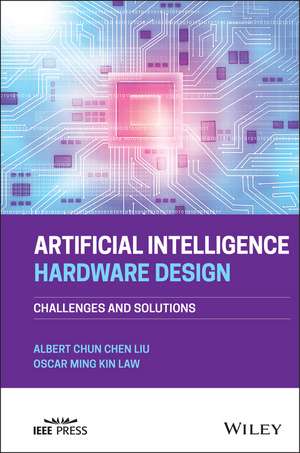Artificial Intelligence Hardware Design – Challenges and Solutions
Autor A. Liuen Limba Engleză Hardback – 6 sep 2021
Learn foundational and advanced topics in Neural Processing Unit design with real-world examples from leading voices in the field
In Artificial Intelligence Hardware Design: Challenges and Solutions, distinguished researchers and authors Drs. Albert Chun Chen Liu and Oscar Ming Kin Law deliver a rigorous and practical treatment of the design applications of specific circuits and systems for accelerating neural network processing. Beginning with a discussion and explanation of neural networks and their developmental history, the book goes on to describe parallel architectures, streaming graphs for massive parallel computation, and convolution optimization.
The authors offer readers an illustration of in-memory computation through Georgia Tech's Neurocube and Stanford's Tetris accelerator using the Hybrid Memory Cube, as well as near-memory architecture through the embedded eDRAM of the Institute of Computing Technology, the Chinese Academy of Science, and other institutions.
Readers will also find a discussion of 3D neural processing techniques to support multiple layer neural networks, as well as information like:
- A thorough introduction to neural networks and neural network development history, as well as Convolutional Neural Network (CNN) models
- Explorations of various parallel architectures, including the Intel CPU, Nvidia GPU, Google TPU, and Microsoft NPU, emphasizing hardware and software integration for performance improvement
- Discussions of streaming graph for massive parallel computation with the Blaize GSP and Graphcore IPU
- An examination of how to optimize convolution with UCLA Deep Convolutional Neural Network accelerator filter decomposition
Perfect for hardware and software engineers and firmware developers, Artificial Intelligence Hardware Design is an indispensable resource for anyone working with Neural Processing Units in either a hardware or software capacity.
Preț: 466.61 lei
Preț vechi: 819.81 lei
-43% Nou
89.29€ • 92.70$ • 74.46£
Carte indisponibilă temporar
Specificații
ISBN-10: 1119810450
Pagini: 240
Dimensiuni: 152 x 229 x 14 mm
Greutate: 0.36 kg
Editura: Wiley
Locul publicării:Hoboken, United States
Descriere
ARTIFICIAL INTELLIGENCE HARDWARE DESIGN
Learn foundational and advanced topics in Neural Processing Unit design with real-world examples from leading voices in the field
In Artificial Intelligence Hardware Design: Challenges and Solutions, distinguished researchers and authors Drs. Albert Chun Chen Liu and Oscar Ming Kin Law deliver a rigorous and practical treatment of the design applications of specific circuits and systems for accelerating neural network processing. Beginning with a discussion and explanation of neural networks and their developmental history, the book goes on to describe parallel architectures, streaming graphs for massive parallel computation, and convolution optimization.
The authors offer readers an illustration of in-memory computation through Georgia Tech's Neurocube and Stanford's Tetris accelerator using the Hybrid Memory Cube, as well as near-memory architecture through the embedded eDRAM of the Institute of Computing Technology, the Chinese Academy of Science, and other institutions.
Readers will also find a discussion of 3D neural processing techniques to support multiple layer neural networks, as well as information like:
- A thorough introduction to neural networks and neural network development history, as well as Convolutional Neural Network (CNN) models
- Explorations of various parallel architectures, including the Intel CPU, Nvidia GPU, Google TPU, and Microsoft NPU, emphasizing hardware and software integration for performance improvement
- Discussions of streaming graph for massive parallel computation with the Blaize GSP and Graphcore IPU
- An examination of how to optimize convolution with UCLA Deep Convolutional Neural Network accelerator filter decomposition
Perfect for hardware and software engineers and firmware developers, Artificial Intelligence Hardware Design is an indispensable resource for anyone working with Neural Processing Units in either a hardware or software capacity.
